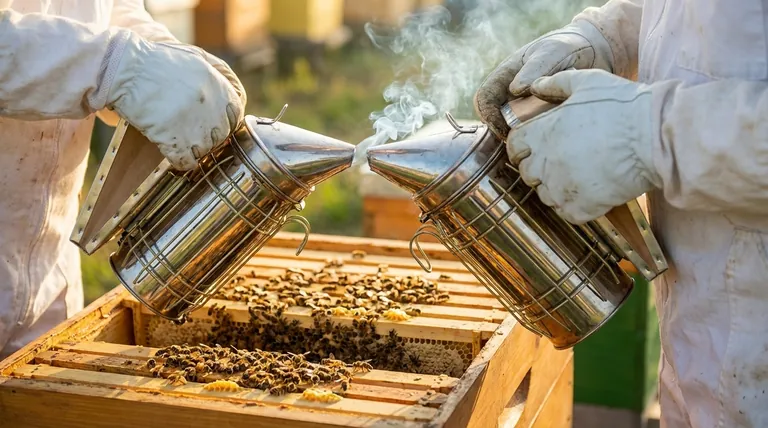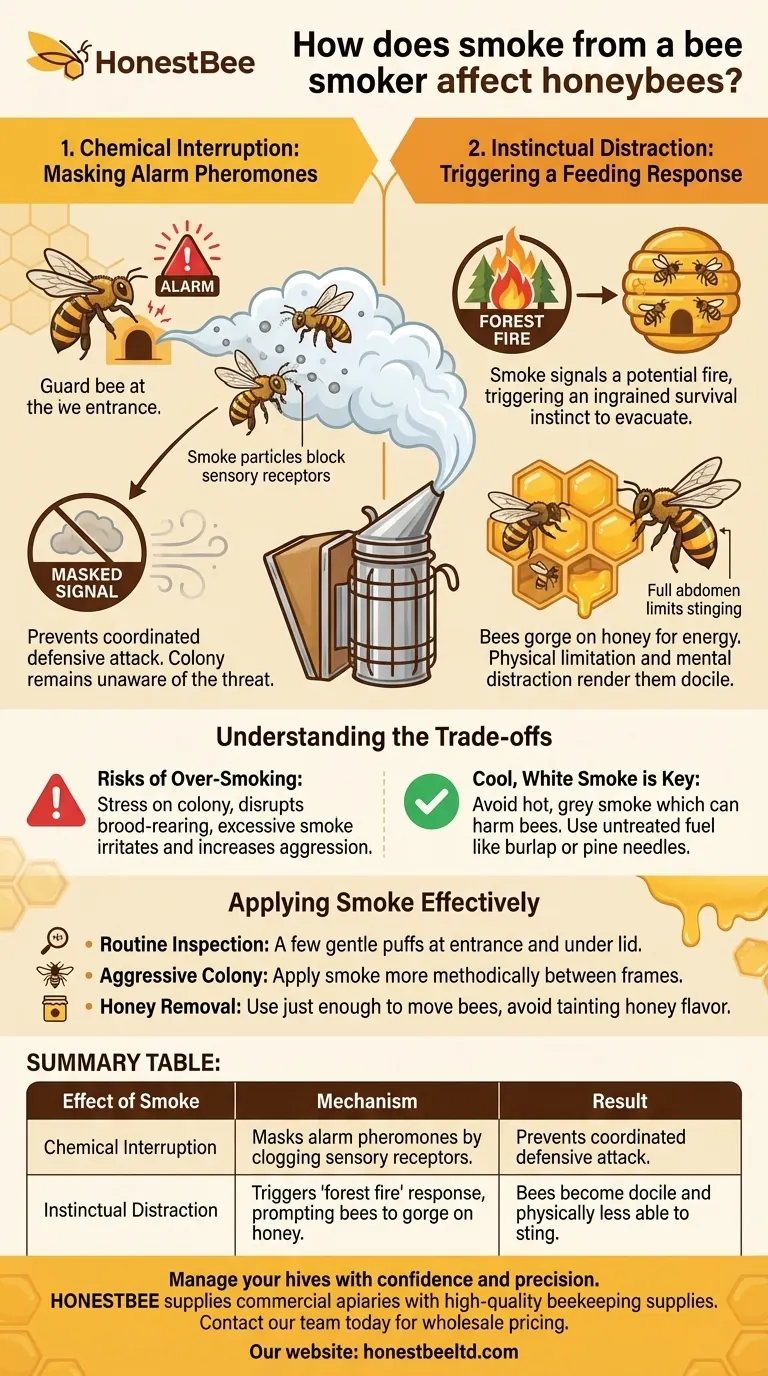When a beekeeper applies smoke to a hive, it is not merely "calming" the bees. The smoke initiates a two-part response: it chemically masks their primary alarm signal and triggers a deep-seated survival instinct. This combination effectively short-circuits their defensive behavior, allowing a beekeeper to safely inspect the colony.
Smoke works by creating sensory chaos. It simultaneously blocks the bees' ability to communicate a threat while convincing them that a larger, more urgent threat—a forest fire—requires them to abandon defense and prepare for evacuation.

The Chemical Interruption: Masking Alarm Pheromones
The most immediate effect of smoke is on the bees' sense of smell, which is central to their social communication.
What is the Alarm Pheromone?
When guard bees perceive a threat, such as a beekeeper opening the hive, they release an alarm pheromone. This chemical signal instantly alerts other bees in the colony to the danger, priming them for a coordinated defensive attack.
How Smoke Interferes
The dense particles in cool, white smoke overwhelm the bees' sensory receptors located on their antennae. These receptors become clogged, making it impossible for them to detect the specific molecules of the alarm pheromone.
Without this signal, the call to arms never spreads. The colony remains unaware of the initial guard bees' panic, preventing a mass defensive response.
The Instinctual Distraction: Triggering a Feeding Response
Beyond just masking communication, smoke triggers a far more profound, evolutionary behavior that distracts the bees from the beekeeper entirely.
The "Forest Fire" Instinct
To honeybees, the smell of smoke signals one thing: a potential forest fire. Their ingrained instinct is not to fight the fire but to prepare to abandon the hive and find a new home.
Gorging on Honey
A colony's first step in preparing for this evacuation is to save its most valuable resource: food. The bees rush to open honey cells and begin to gorge themselves, filling their honey stomachs with as much nectar as they can carry.
This provides them with the energy reserves needed to fly a long distance and begin building a new wax comb in a safer location.
The Pacifying Side Effect
This act of gorging has a direct physical consequence. When a bee’s abdomen is full of honey, it becomes difficult for her to flex it into the proper position to sting. This physical limitation, combined with the mental distraction of an impending "evacuation," renders the bees significantly more docile and less likely to attack.
Understanding the Trade-offs
Smoke is a powerful tool, but its misuse can be counterproductive or harmful.
The Risk of Over-Smoking
Using too much smoke can cause significant stress on the colony. It can drive bees off the comb, disrupt brood-rearing, and, in extreme cases, cause them to absorb the smoky flavor into uncapped honey. Excessive smoke can also irritate the bees and make them more aggressive.
Cool, White Smoke is Key
The goal is to produce cool, white smoke, not hot, grey smoke. Hot smoke can burn the bees' delicate wings and even kill them. The type of fuel used in the smoker is critical; untreated burlap, pine needles, or cotton are standard choices that burn slowly and coolly.
Smoke Isn't a Substitute for Gentleness
Smoke makes bees more manageable, but it doesn't make them immune to agitation. Slow, deliberate movements are just as crucial for a calm hive inspection. Jerky motions or squashing bees will still provoke a defensive reaction, regardless of how much smoke is used.
Applying Smoke Effectively
Your use of smoke should be deliberate and tailored to the situation.
- If your primary focus is a routine inspection: A few gentle puffs at the hive entrance and a few more under the lid are usually sufficient to disrupt initial alarms and get the bees focused on the honey stores.
- If you encounter an aggressive colony: Apply smoke more methodically between the frames as you work. This keeps the lines of communication broken and prevents the defensive response from building back up.
- If you are removing honey: Use just enough smoke to move the bees away from the honey frames you intend to harvest, but avoid over-smoking, which can taint the flavor of the honey.
By understanding this dual-action effect, you can use smoke not as a weapon, but as a precise instrument for cooperative hive management.
Summary Table:
| Effect of Smoke | Mechanism | Result |
|---|---|---|
| Chemical Interruption | Masks alarm pheromones by clogging sensory receptors. | Prevents coordinated defensive attack. |
| Instinctual Distraction | Triggers 'forest fire' response, prompting bees to gorge on honey. | Bees become docile and physically less able to sting. |
Manage your hives with confidence and precision. The right equipment is essential for applying smoke effectively and maintaining a healthy, productive colony. HONESTBEE supplies commercial apiaries and beekeeping equipment distributors with high-quality, wholesale-focused beekeeping supplies and equipment. Let's discuss your apiary's needs — contact our team today to learn more about our products and wholesale pricing.
Visual Guide

Related Products
- European Stainless Steel Bee Smoker for Honey Bee Hive
- Professional Bee Smoker with Elongated Spout and Durable Bellows for Beekeeping
- Premium Traditional Copper Bee Smoker with Bellows
- Economy Galvanized Beekeeping Honey Bee Smoker for Wholesale
- Heavy Duty Manual Bee Smoker Blower for Beekeeping
People Also Ask
- Can you use too much smoke on bees? The Right Way to Use a Bee Smoker for Calm Inspections
- What are the differences between stainless steel and galvanized steel bee smokers? Choose the Right Smoker for Your Apiary
- What are the benefits of smoking bees? Achieve Safer, Calmer Hive Inspections
- What factors should be considered when choosing a bee smoker? Find the Right Tool for Safe, Effective Hive Management
- What are the features of a recommended bee smoker? A Guide to Safety, Durability & Performance



















